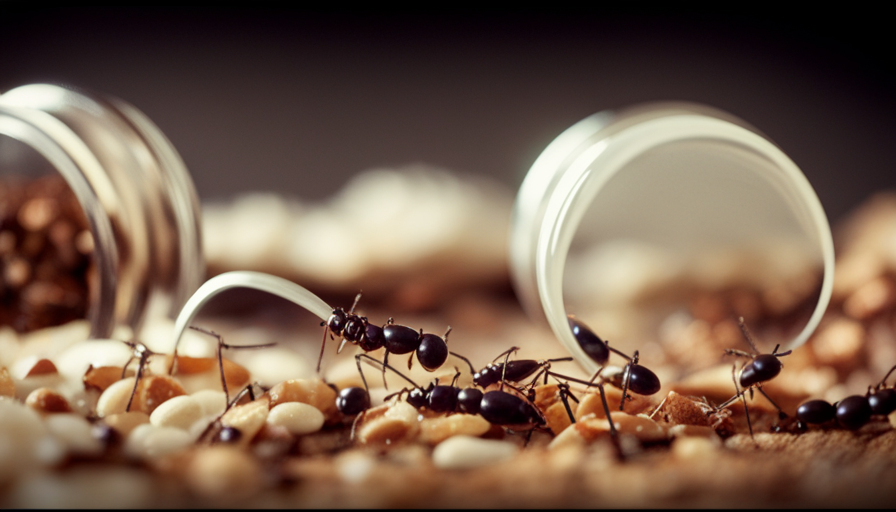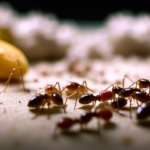Hello! It appears that you have a pesky ant problem in your home, right? No need to fret, as I’m here to help you eliminate those tiny intruders once and for all.
In this article, we’ll delve into the world of ant control and discover some effective strategies to get rid of those annoying critters for good.
First things first, it’s important to identify the ant species you’re dealing with. Different ants require different approaches, so knowing your enemy is crucial. Once you’ve figured that out, we’ll move on to locating their trails and nest, because, let’s face it, we need to know where they’re coming from to effectively eliminate them.
Next up, we’ll tackle cleaning and removing any food sources that may be attracting them. Remember, a clean home is an ant-free home. Then, we’ll explore the wonderful world of natural ant repellents – trust me, there are some fantastic options out there that won’t harm your furry friends or little ones.
But we won’t stop there! We’ll also discuss sealing entry points to prevent future invasions and setting up ant baits for those sneaky stragglers. Finally, we’ll emphasize the importance of regularly monitoring and maintaining your ant control efforts to ensure a long-lasting ant-free environment.
So buckle up, my friend, because we’re about to embark on a journey to reclaim your home from these tiny trespassers. Let’s get started on banishing those ants once and for all!
Key Takeaways
- Identify and locate ant trails and nests to effectively target control efforts.
- Clean and remove food sources to greatly reduce the chances of ant infestation.
- Use natural ant repellents like vinegar and lemon juice as safe and effective alternatives to chemical repellents.
- Seal entry points, such as cracks and gaps, to prevent ants from entering your home.
Identify the Ant Species
When dealing with tiny ants in your house, it’s important to identify the ant species so you can strategize your battle against these tiny invaders. By understanding the specific ant species, you can gain insights into their behavior patterns and select the most effective ant control methods.
Different ant species have different preferences for food, nesting locations, and behaviors. For example, some ants may be attracted to sugary substances while others may prefer protein-based foods. Additionally, certain ant species may establish their nests inside walls, while others may build their nests outside.
By identifying the ant species, you can locate the ant trails and nest, which will help you in the subsequent section about ‘locate the ant trails and nest’ without writing ‘step’.
Locate the Ant Trails and Nest
First, it’s important to pinpoint the trails and nest of those pesky little creatures. To effectively control ants in your house, you need to identify their routes and locate their nest.
Look for signs of ant infestation, such as small trails of ants moving in a line or congregating near food sources. Follow these trails to find the nest, which is usually located near a food or water source.
Once you locate the nest, you can use effective ant control methods to eliminate the problem. This may include using ant baits or sprays specifically designed for indoor ant control. By addressing the source of the infestation, you can effectively eradicate the ants from your home.
Now, let’s move on to the next step of the process: cleaning and removing food sources.
Clean and Remove Food Sources
To effectively control ants in your home, make sure you’re cleaning and removing any sources of food that may be attracting them. Ants are constantly searching for food, and even the tiniest crumbs can be enticing to them. Preventive measures such as keeping your kitchen clean and storing food in airtight containers can greatly reduce the chances of an ant infestation.
Additionally, make sure to promptly clean up spills and crumbs, and empty your garbage regularly. If you still have ants despite your best efforts, there are alternative methods you can try. Use natural ant repellents like vinegar or lemon juice, as ants dislike the strong smell and taste. These methods can help deter ants and minimize their presence in your home.
Transitioning into the subsequent section, let’s explore how to use natural ant repellents effectively.
Use Natural Ant Repellents
For effective ant control in your home, you can use natural ant repellents to deter their presence and minimize their impact. Using DIY ant repellent recipes is a safe and effective way to keep ants away without the use of harmful chemicals.
One popular recipe involves mixing equal parts vinegar and water and spraying it in areas where ants are commonly found. Another option is to create a mixture of lemon juice and water and spray it on surfaces to repel ants.
The benefits of using natural ant repellents are twofold: they’re environmentally friendly and they don’t pose any health risks to humans or pets. By using natural repellents, you can effectively keep ants at bay and create a safer living environment.
Now, let’s move on to the next step: sealing entry points to prevent ants from entering your home.
Seal Entry Points
Now, let me show you how you can keep those pesky little ants out of your home by sealing any entry points they may be using.
One effective method to prevent ants from infiltrating your house is to repair cracks and block openings. Inspect your walls, floors, and foundation for any visible cracks or gaps. Use a sealant or caulk to fill in these openings, ensuring a tight seal. Pay extra attention to areas around windows, doors, and pipes, as ants can easily squeeze through even the tiniest gaps.
Additionally, consider installing weatherstripping to create a barrier against these tiny invaders.
By taking these proactive measures, you can greatly reduce the chances of ants finding their way into your home.
Now, let’s move on to the next step – setting up ant baits.
Set Up Ant Baits
Once you’ve sealed all the entry points, it’s time to set up ant baits and lure those pesky critters away from your home.
Ant baits are an effective method for attracting ants and eliminating them at their source. Here are three important things to keep in mind when setting up ant baits:
-
Placement: Put the ant baits in areas where you’ve seen ant activity, such as along their trails or near their nests. This increases the chances of attracting ants to the bait.
-
Type of bait: Choose ant baits that are specifically designed to attract the type of ants you have in your house. Different species of ants may be attracted to different types of bait, so using the right one is crucial for success.
-
Alternative ant control methods: While ant baits are highly effective, it’s important to consider using alternative ant control methods as well. These may include natural repellents, such as lemon juice or vinegar, or physical barriers like cinnamon or diatomaceous earth.
Once you’ve set up the ant baits, regularly monitor and maintain ant control to ensure long-term success in keeping your home ant-free. Transitioning into the subsequent section about ‘regularly monitor and maintain ant control,’ it’s essential to stay proactive in managing ant infestations.
Regularly Monitor and Maintain Ant Control
To keep your home ant-free and maintain effective ant control, it’s important for you to regularly monitor and maintain the ant baits and other methods you have in place. This ensures that any ant infestations are promptly identified and dealt with. Additionally, taking preventive measures against ant infestations is crucial. Here are some tips to help you maintain a clean and hygienic home environment that discourages ants from invading:
- Keep your kitchen and dining areas clean and free of crumbs or spills.
- Store food in airtight containers to prevent ants from accessing it.
- Seal any cracks or crevices in your walls, windows, and doors to prevent ants from entering.
- Remove any standing water sources inside or outside your home.
- Trim bushes and trees near your house to prevent ants from using them as pathways.
By following these preventive measures and regularly monitoring your ant control methods, you can effectively keep ants out of your home and maintain a hygienic living environment.
Frequently Asked Questions
How can I prevent ants from entering my house in the first place?
To prevent ants from invading my house, I rely on effective home remedies that keep them at bay. By implementing preventive measures, such as sealing cracks and crevices, maintaining cleanliness, and storing food properly, I greatly reduce the chances of ant infestations.
These simple yet powerful techniques create a barrier that deters ants from entering my home. With these strategies in place, I can enjoy a pest-free environment and peace of mind.
Are there any specific types of natural ant repellents that work better than others?
There are indeed specific types of natural ant repellents that can work better than others. Some effective DIY methods to get rid of ants in your house include using vinegar, lemon juice, cinnamon, or peppermint oil. These substances have strong scents that ants find unpleasant and can help deter them from entering your home.
Additionally, sealing cracks and keeping your house clean and free of food debris can also help prevent ants from coming inside.
Can ants cause any damage to my house?
Ants can indeed cause structural damage to your house. They may excavate wood, compromising its integrity over time. Additionally, ants can affect the electrical wiring in your home by nesting near or even inside electrical outlets, potentially leading to short circuits or electrical fires.
It’s crucial to address ant infestations promptly to prevent any potential harm to your house.
How long does it typically take to completely get rid of ants?
To completely get rid of ants, the time it typically takes can vary depending on several factors. Factors such as the size of the infestation, the type of ant species, and the effectiveness of the chosen elimination methods can all influence the duration.
However, there are ways to speed up the process of eliminating ants. Implementing a combination of baiting, sealing entry points, and maintaining cleanliness can help expedite the elimination process and prevent future infestations.
Is it necessary to hire a professional pest control service for ant infestations?
Personally, I’ve dealt with my fair share of ant infestations, and I’ve found that DIY ant control methods can be effective. However, when it comes to serious ant infestations, hiring a professional pest control service is often necessary.
While DIY methods may save you money upfront, they can take time and effort, and the results may not be as thorough. On the other hand, professional services offer expertise and guaranteed results, making them a cost-effective option in the long run.
Conclusion
Well, after implementing all these steps, I can confidently say that my house is now an ant-free paradise. Those tiny invaders didn’t stand a chance against my cunning strategies and relentless determination.
Every nook and cranny has been thoroughly inspected and sealed, leaving no room for those pesky ants to sneak in. With natural ant repellents and strategically placed ant baits, I’ve taken control of the situation.
And with regular monitoring and maintenance, I can ensure that my victory over the tiny ant army remains unchallenged. Say goodbye to those minuscule pests because my house is now an ant-free fortress.
Hi, I’m Emma. I’m the Editor in Chief of Tiny House 43, a blog all about tiny houses. While tree houses are often associated with childhood, they can be the perfect adult retreat. They offer a cozy space to relax and unwind, surrounded by nature. And since they’re typically built on stilts or raised platforms, they offer stunning views that traditional homes simply can’t match. If you’re looking for a unique and romantic getaway, a tree house tiny house might just be the perfect option.
















